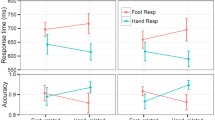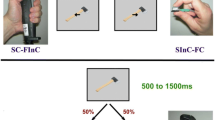Abstract
Action affordances can be activated by non-target objects in the visual field as well as by word labels attached to target objects. These activations have been manifested in interference effects of distractors and words on actions. We examined whether affordances could be activated implicitly by words representing graspable objects that were either large (e.g., APPLE) or small (e.g., GRAPE) relative to the target. Subjects first read a word and then grasped a wooden block. Interference effects of the words arose in the early portions of the grasping movements. Specifically, early in the movement, reading a word representing a large object led to a larger grip aperture than reading a word representing a small object. This difference diminished as the hand approached the target, suggesting on-line correction of the semantic effect. The semantic effect and its on-line correction are discussed in the context of ecological theories of visual perception, the distinction between movement planning and control, and the proximity of language and motor planning systems in the human brain.


Similar content being viewed by others
References
Arbib MA (1997) From visual affordances in monkey parietal cortex to hippocampo-parietal interactions underlying rat navigation. Philos Trans R Soc Lond B Biol Sci 29:1429–1436
Buccino G, Binkofski F, Fink GR, Fadiga L, Fogassi L, Gallese V, Seitz RJ, Zilles K, Rizzolatti G, Freund H-J (2001) Action observation activates premotor and parietal areas in a somatotopic manner: an fMRI study. Eur J Neurosci 13:400–404
Buchanan L, McEwen S, Westbury C, Libben G (2003) Semantics and semantic errors: implicit access to semantic information from words and nonwords in deep dyslexia. Brain Lang 84:65–83
Castiello U (1996) Grasping a fruit: selection for action. J Exp Psychol Hum Percept 22:582–603
Castiello U (1998) Attentional coding for three-dimensional objects and two-dimensional shapes. Differential interference effects. Exp Brain Res 123:289–297
Damasio H, Damasio A (1989) Lesion analysis in neuropsychology. Oxford University Press, Oxford
Deiber M-P, Ibanez V, Sadato N, Hallett M (1996) Cerebral structures participating in motor preparation in humans: a positron emission tomography study. J Neurophys 75:233–247
Dixon P (1998) Why scientists value p values. Psychonom Bull Rev 5:390–396
Dixon P, O’Reilly T (1999) Scientific versus statistical inference. Can J Exp Psychol 53:133–149
Franz VH, Gegenfurtner KR, Bulthoff HH, Fahle M (2000) Grasping visual illusions: no evidence for a dissociation between perception and action. Psychol Sci 11:20–25
Gentilucci M (2002) Object motor representation and language. Neuropsychologia 40:1139–1153
Gentilucci M, Gangitano M (1998) Influence of automatic word reading on motor control. Eur J Neurosci 10:752–756
Gentilucci M, Benuzzi F, Bertolani L, Daprati E, Gangitano M (2000) Language and motor control. Exp Brain Res 133:468–490
Gibson JJ (1979) The ecological approach to visual perception. Houghton-Mifflin, Boston, MA
Glover S (2002) Visual illusions affect planning but not control. Trends Cogn Sci 6:288–292
Glover S (in press) Separate visual representations in the planning and control of actions. Behav Brain Sci
Glover S (2003) Optic ataxia as a deficit specific to the on-line control of actions. Neurosci Biobehav Rev 27:447-456
Glover S, Dixon P (2001a) Dynamic illusion effects in a reaching task: evidence for separate visual representations in the planning and control of reaching. J Exp Psychol Hum Percept 27:560–572
Glover S, Dixon P (2001b) Motor adaptation to an optical illusion. Exp Brain Res 137:254–258
Glover S, Dixon P (2002a) Semantics affect the planning but not control of grasping. Exp Brain Res 146:383–387
Glover S, Dixon P (2002b) Dynamic effects of the Ebbinghaus illusion in grasping: support for a planning/control model of action. Percept Psychophys 64:266–278
Goodman SN, Royall R (1988) Evidence and scientific research. Am J Public Health 78:1568–1574
Grafton ST, Fagg A, Arbib MA (1998) Dorsal premotor cortex and conditional movement selection: a PET functional mapping study. J Neurophys 79:1092–1097
Humphreys GW, Riddoch MJ (2000) One more cup of coffee for the road: object-action assemblies, response blocking and response capture after frontal lobe damage. Exp Brain Res 133:81–93
Jakobson LS, Goodale MA (1991) Factors affecting higher-order movement planning: a kinematic analysis of human prehension. Exp Brain Res 86:199–208
Jeannerod M (1984) The timing of natural prehension movements. J Mot Behav 16:235–254
Jeannerod M (1994) The representing brain: neural correlates of motor intention and imagery. Behav Brain Sci 17:187–245
Kimura D (1979) Neuromotor mechanisms in the evolution of human communication. In: Steklis HD, Raleigh M (eds) Neurobiology of social communication in primates: an evolutionary perspective. Academic Press, New York
Kolb B, Whishaw IQ (1995) Fundamentals of human neuropsychology. Freeman, New York
Le S, Raufaste E, Roussel S, Puel M, Demonet JF (2003) Implicit face perception in a patient with visual agnosia? Evidence from behavioral and eye-tracking analyses. Neuropsychologia 41:702–712
Lhermitte F (1983) Utilization behaviour and its relation to lesions of the frontal lobes. Brain 106:237–255
Oldfield RC (1971) The assessment and analysis of handedness: the Edinburgh inventory. Neuropsychologia 9:97–113
Petersen SE, Fox P, Posner M, Mintun M, Raichle M (1988) Positron emission tomography studies of the cortical anatomy of single word processing. Nature 331:585–589
Price CJ, Wise R, Watson J, Patterson K, Howard D, Frackowiak R (1994) Brain activity during reading: the effects of exposure duration and task. Brain 117:1255–1269
Rizzolatti G, Arbib MA (1998) Language within our grasp. Trends Neurosci 21:188–194
Rosenbaum DA (1991) Human motor control. Academic Press, San Diego
Rushworth MF, Ellison A, Walsh V (2001) Complementary localization and lateralization of orienting and motor attention. Nature Neurosci 4:643–662
Schendan HE, Searl MM, Melrose RJ, Stern CE (2003) An fMRI study of the role of the medial temporal lobe in implicit and explicit sequence learning. Neuron 27:1013–1025
Wing AM, Fraser C (1983) The contribution of the thumb to reaching movements. Q J Exp Psychol 35A:297–309
Wing AM, Turton A, Fraser C (1986) Grasp size and accuracy of approach in reaching. J Motor Behav 18:245–260
Wolpert DM, Ghahramani Z (2000) Computational principles of movement neuroscience. Nat Neurosci Suppl 3:1212–1217
Acknowledgements
This work was supported by the Natural Sciences and Engineering Research Council, through a fellowship to SG and a grant to PD, as well as by NIH grant 1 R15 NS41887-01 to Jonathan Vaughan, Hamilton College, Clinton, New York, for which the second author was a consultant.
Author information
Authors and Affiliations
Corresponding author
Rights and permissions
About this article
Cite this article
Glover, S., Rosenbaum, D.A., Graham, J. et al. Grasping the meaning of words. Exp Brain Res 154, 103–108 (2004). https://doi.org/10.1007/s00221-003-1659-2
Received:
Accepted:
Published:
Issue Date:
DOI: https://doi.org/10.1007/s00221-003-1659-2




